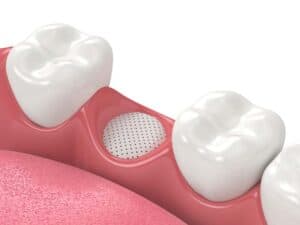Bone grafting is a fairly common procedure that is used to prompt healthy bone growth and restore bone density and strength to a specific area of the body. In the case of dentistry and specifically implantology, this refers to adding bone to the jaw so that dental implants can be successfully placed.
When a tooth is extracted, a socket (space) remains where the tooth used to be. In the past, if a patient had a loose tooth or a tooth that needed to be extracted, we may have kept the tooth for as long as the patient was comfortable, and then extracted the tooth and fabricated a bridge or a removable denture to replace the missing tooth. We also would let the body fill-in the healing socket on its own.

Today, with the increased success, popularity and availability of dental implants, it is necessary to preserve as much bone as possible in order to facilitate implant placement. The success of dental implants depends in part on the amount of bone available to hold the implant, and as such we want to preserve as much bone as possible when we take out a tooth.
A bone graft is a section of material that is placed in the empty tooth socket at the time of extraction - with the goal of trying to make sure that enough bone is available for placement of a dental implant. If you are planning to have a dental implant placed or if you are considering having a dental implant placed where you had the tooth out, it’s important to consider having a bone graft. The reason you should consider the graft at the time of extraction is because once the socket completely heals on its own, it is much more difficult to get a successful graft in place.
Yes. Grafting can be done in many clinical situations, but the most successful grafts are done at the time of extraction.
The bone graft process itself involves removing a small piece of bone from another part of your jaw or body, and transplanting it onto the area of the jaw where the dental implant will be placed. Sometimes the actual bone is not used and instead a synthetic substance is placed into the area. Both approaches have been shown to be very effective at stimulating new bone growth. And to help the bone regenerate, the graft is usually covered with a collagen membrane. This membrane acts as a scaffold onto which your body will build new bone.
Bone grafting can typically be performed using just a local anesthetic like with a regular filling, although sedation can also be provided for patients who are particularly anxious. Since a small incision is required into the gum to place the graft, you may find that the tissue around the incision is a little sore for a few days after your procedure. However, this can usually be managed using over the counter pain relief.
It can take a number of months for the bone graft to create enough new bone to successfully support a dental implant. For this reason, we won’t schedule your implant surgery for around 4-6 months after your bone grafting procedure.
If you would like more information about dental implants or bone grafting, or if you would like to schedule an appointment in our Brooklyn, NY office to determine if you are a candidate for these procedures, please get in touch with our experienced team.

© 2021 New York Institute of Oral and Maxillofacial Surgery - HIPAA Notice / Privacy Policy - Terms - Accessibility Statement